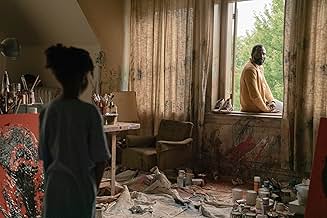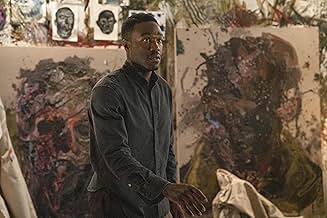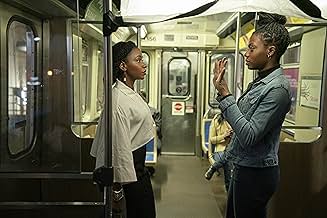Uma "sequência espiritual" do filme de terror de 1992 "Candyman", que retorna ao bairro de Chicago, agora gentrificado, onde a lenda começou.Uma "sequência espiritual" do filme de terror de 1992 "Candyman", que retorna ao bairro de Chicago, agora gentrificado, onde a lenda começou.Uma "sequência espiritual" do filme de terror de 1992 "Candyman", que retorna ao bairro de Chicago, agora gentrificado, onde a lenda começou.
- Direção
- Roteiristas
- Artistas
- Prêmios
- 10 vitórias e 24 indicações no total
Rodney L Jones III
- Billy
- (as Rodney L. Jones III)
Avaliações em destaque
Well, it has all the components - say his name five times, the hook for a hand, and the bees! And the 'puppet' animation, especially over the end credits is amazing! But the story seemed very muddled, and I'm not even sure I understand what happened at the end. I like the idea of the hive, and of Candyman standing for all the racial injustices suffered in this country, I just found the story itself to be very confusing.
But that puppet stuff - true works of art!
But that puppet stuff - true works of art!
I saw the original 'Candyman' film back when I was very young. I remember being completely bored by it. It wasn't scary then, and it certainly isn't scary now. A good test would be to go to the mirror after seeing this and say "Candyman" five times over. If it's easy to do then the movie has not done its job.
It felt like this version of 'Candyman' was so intent on giving a political message that it forgot to be an enjoyable film along the way. It's ridiculously preachy and self-righteous. It's not ever what I want out of a horror movie (or any film for that matter).
The characters are extremely bland, the scares are more or less non-existent, the concept is stupid and the film refuses to get off its high-horse. There are far better ways to spend your time and money than this film. Not recommended. 4/10.
It felt like this version of 'Candyman' was so intent on giving a political message that it forgot to be an enjoyable film along the way. It's ridiculously preachy and self-righteous. It's not ever what I want out of a horror movie (or any film for that matter).
The characters are extremely bland, the scares are more or less non-existent, the concept is stupid and the film refuses to get off its high-horse. There are far better ways to spend your time and money than this film. Not recommended. 4/10.
This sequel expanded on Candyman's muddled fictional mythology and mixed this mythology with some real people and events to give sociological and political background on some hot topics like racism and injustice to African Americans in the United States. I found it strange that they mixed some real-life racism-related crimes and their victims with a classic horror movie's fictional story for social commentary, but it's just my personal opinion. There are too many problems in this sequel, and I think the biggest problem is that this movie is definitely not as scary and thrilling as the first one. It's narrative is also unfocused, and that makes the story hard to follow because they crammed too many things into the script, which makes the script kind of messy, drawn out, and convoluted. I wasn't also impressed by the acting. The main guy's acting is really wooden; the character he played is also quite bland and hard to empathize with, and the supporting actors and characters aren't better than him. The movie is also quite slow-paced. It lasts 1.30 hours, but it feels much longer because of its slowness. Overall, I found this movie less scary and less enjoyable. It's a well-made movie; that's why I didn't give a low point, but it just couldn't give you the first movie's suspense, thrill, and horror.
Nia DaCosta/Jordan Peele's "Candyman" sequel ("Candymen" might have been better title) breathes new life into the 30 year franchise by finding a new angle to the story. It keeps the same type of classy direction of Bernard Rose and Bill Condon of the first two films, while tackling themes of gentrification, police britality, and artists' mindless appropriation of violent tragedies. It links to the first film, while incorporating mythogy of the second film.
This movie is best appreciated at night with the lights off, and with headphones or a good sound system. John Guleserian's cinematography is great, the narrative shadow puppets were cool, and Lichens' score is consistently disturbing, while incorporating Glass' score of the original.
The screenplay however is uneven. The conversation of gentrification is intelligent amd balanced. So is the coverage of artists being insensitive and uncaring about the victims of the violence they depict, while focusing instead on their own fame. But the police brutality story is uneven, and some references to recent events ("Say his name") feel tacked on. The events depicted do match real life stories and can elicit empathy and rally against injustice. While Chicago police do disproportionately intervene African-Americans, and fheir is a history of brutality, an all-white modern day large Chicago police squad does not correspond with reality.
I dismiss others' complaints that 'all the victims are white'. No, not all are, and it is similar to the victim make-up of all the other "Candyman" movies: mostly white teen girls and white intellectual snobs, with the non-supernatural violence done by modern-day African-Americans against others, and in flashbacks, by racist whites. I will agree that the kill scenes themselves are inconsistently executed.
The bigger issue is that the story itself feels rewritten by people who did not agree on what was going on, and it falls apart in the last 20 minutes. The journey of Anthony's character makes no sense, nor does that of Billy, his guide into Candyman mythology. His girlfriend Brianna, the wealthy art exhibitor, has a distrubing backstory revelead halfway that is never developed. Mutliple variations of the Candyman are described, but only a couple are shown. If there was a succession and another variant took over 45 years ago, then why do we instead have the original in the previous films? Shouln't it had been the next one? At times they keep the original concept of Candyman as an urban legend of an atrocity that should not be mocked within ita community nor trivialized by outsiders, but then it is switched to a vigilante dishing out justice. The rules as to what happens when the name is called out are quite variable.
The acting is variable. The great Tony Todd is barely in the film. The child actors are good. Most of the snobby supporting cast overacts. Yaya Abdul Mateen II continues his streak of mixing in great acting with forced, overly conscious acting. Teyonah Parris does well with what they give her, and Colman Domingo is fine. Vanessa A. Williams steals the scene in which she is in.
This movie is best appreciated at night with the lights off, and with headphones or a good sound system. John Guleserian's cinematography is great, the narrative shadow puppets were cool, and Lichens' score is consistently disturbing, while incorporating Glass' score of the original.
The screenplay however is uneven. The conversation of gentrification is intelligent amd balanced. So is the coverage of artists being insensitive and uncaring about the victims of the violence they depict, while focusing instead on their own fame. But the police brutality story is uneven, and some references to recent events ("Say his name") feel tacked on. The events depicted do match real life stories and can elicit empathy and rally against injustice. While Chicago police do disproportionately intervene African-Americans, and fheir is a history of brutality, an all-white modern day large Chicago police squad does not correspond with reality.
I dismiss others' complaints that 'all the victims are white'. No, not all are, and it is similar to the victim make-up of all the other "Candyman" movies: mostly white teen girls and white intellectual snobs, with the non-supernatural violence done by modern-day African-Americans against others, and in flashbacks, by racist whites. I will agree that the kill scenes themselves are inconsistently executed.
The bigger issue is that the story itself feels rewritten by people who did not agree on what was going on, and it falls apart in the last 20 minutes. The journey of Anthony's character makes no sense, nor does that of Billy, his guide into Candyman mythology. His girlfriend Brianna, the wealthy art exhibitor, has a distrubing backstory revelead halfway that is never developed. Mutliple variations of the Candyman are described, but only a couple are shown. If there was a succession and another variant took over 45 years ago, then why do we instead have the original in the previous films? Shouln't it had been the next one? At times they keep the original concept of Candyman as an urban legend of an atrocity that should not be mocked within ita community nor trivialized by outsiders, but then it is switched to a vigilante dishing out justice. The rules as to what happens when the name is called out are quite variable.
The acting is variable. The great Tony Todd is barely in the film. The child actors are good. Most of the snobby supporting cast overacts. Yaya Abdul Mateen II continues his streak of mixing in great acting with forced, overly conscious acting. Teyonah Parris does well with what they give her, and Colman Domingo is fine. Vanessa A. Williams steals the scene in which she is in.
The story didn't really work for me. I found it disturbing, but not thrilling or scary. It was quite slow paced, and lacks suspense.
Você sabia?
- CuriosidadesProduction was brought back to the Cabrini Green neighborhood where O Mistério de Candyman (1992) was filmed. Though the high-rise buildings have long been demolished, the Rowhouses still exist.
- Erros de gravaçãoHaley reads from the program describing Say My Name at the Night Driver gallery. The program reads 'In foreground, Helen Lyle: a white, privileged, graduate student whose obsession with her research into a [sic] an urban legend called, "Candyman," led to her bizarre self-emulation in the housing projects courtyard in the early 90's.' The word "emulation" is confused with "immolation", which means death by fire.
- Citações
Detective Lipez: Who are you?
Anthony McCoy: I am the writing on the walls. I am the sweet smell of blood on the street. The buzz that echoes in the alleyways. They will say I shed innocent blood. You are far from innocent, but they will say you were. That's all that matters.
- Cenas durante ou pós-créditosThe opening Universal Studios, Metro-Goldwyn-Mayer, Bron Studio, and Monkeypaw Productions logos are mirrored images. The opening credits of Chicago skyline seen from below, are a "mirrored" concept of O Mistério de Candyman (1992)'s opening credits of Chicago seen from above.
- Trilhas sonorasThe Candy Man
Written by Leslie Bricusse & Anthony Newley
Performed by Sammy Davis Jr.
Courtesy of Republic Records
Under license from Universal Music Enterprises
Principais escolhas
Faça login para avaliar e ver a lista de recomendações personalizadas
- How long is Candyman?Fornecido pela Alexa
Detalhes
- Data de lançamento
- Países de origem
- Centrais de atendimento oficiais
- Idiomas
- Também conhecido como
- Candyman
- Locações de filme
- DeKalb, Illinois, EUA(Library Scene)
- Empresas de produção
- Consulte mais créditos da empresa na IMDbPro
Bilheteria
- Orçamento
- US$ 22.000.000 (estimativa)
- Faturamento bruto nos EUA e Canadá
- US$ 61.186.570
- Fim de semana de estreia nos EUA e Canadá
- US$ 22.001.750
- 29 de ago. de 2021
- Faturamento bruto mundial
- US$ 77.411.570
- Tempo de duração1 hora 31 minutos
- Cor
- Mixagem de som
- Proporção
- 2.39 : 1
Contribua para esta página
Sugerir uma alteração ou adicionar conteúdo ausente







































